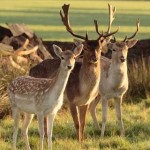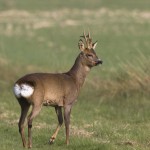Harewood has been home to a deer park since the medieval era with three types of deer spread over 4,000 acres of land. There are approximately 155 Red, 45 Fallow and 45 Roe with the number fluctuating when the calves are born around June.
The Red deer is one of the largest deer species and, although they were once rare in parts of Europe, they were never closetoextinction. Successful reintroduction and conservation efforts, particularly within the UK, have resulted in an increase of Red deer populations. This species have varying colouration depending on the season and habitat in which they live, with grey or lighter colouration in winter and more reddish and darker coat colouration in the summer.
Native to Western Eurasia, the Fallow deer can be identified by its chestnut coat with white mottles in summer or by a much darker, unspotted coat in the winter. Fallow deer are widespread on the UK mainland and are present in most of England and Wales.
The Roe deer is relatively small with reddish and grey-brown colouring, and well adapted to cold environments. The roe deer is renowned for being very quick and graceful with very short antlers. The world-famous deer Bambi was based on a Roe deer but was changed to a White-Tailed deer upon its feature film adaptation.
Male deer cast antlers each year, usually in April, with the oldest deer’s casting their antlers first. Deer are herbivores meaning they eat fruits, acorns and nuts as well as grass and evergreen plants in the autumn and winter.
You can currently purchase venison from Home Park.



